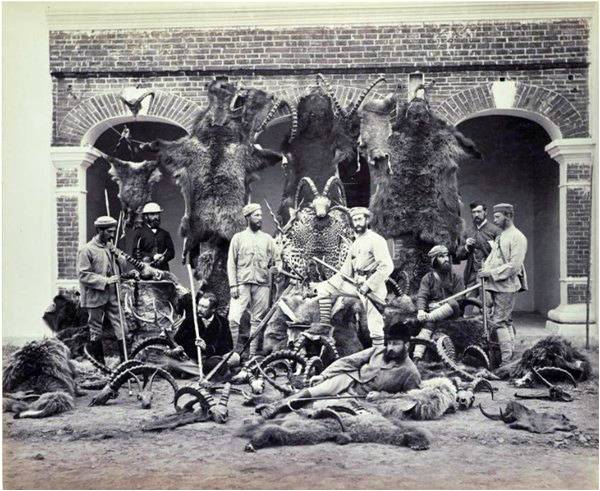
A group portrait of officers of the 93rd Regiment posed with their rifles amongst a ‘large array of hunting trophies including antelope horns, bear skins and leopard skins’. This is part of a collection of photographs by Samuel Bourne and Charles Shepherd. The collection originally consisted of a heavy, custom-made wooden box containing large leather bound albums, each stamped in gold ‘India 1872’.
Samuel Bourne (1834-1912) is regarded as one of the finest commercial photographers of the 19th century. In 1862 he set sail for India to work as a professional photographer, arriving in Calcutta early in 1863. Bourne mentions travelling to Sialkot to photograph this group at this end of his nine month trip to Kashmir in 1864.
In July 1863 left the hill station Simla for a trip into the Himalayas. With a retinue of 30 coolies he travelled to Chini, 160 miles north-east of Simla, and spent some time photographing in the Chini-Sutlej River area before heading west to Spiti and returning to Simla on October 12 with 147 negatives. At around this time Bourne entered into the first of the commercial partnerships which was later to become the firm of Bourne and Shepherd and which still flourishes to this day in Calcutta.
In the following year Bourne set out on the longest of his expeditions, a nine-month trip to Kashmir. Leaving Lahore on March 17, he journeyed north-east to Kangra and from there, via Baijnath, Holta, Dharamshala and Dalhousie, travelled to Chamba. He left Chamba for Kashmir on June 8 and by the middle of the month had reached the Chenab Valley. The following weeks were spent photographing the scenery of Kashmir before proceeding to Srinagar, where he stopped for some weeks, sight seeing and photographing, before continuing his journey on September 15. The return journey took in the Sind Valley, Baramulla, Murree, Delhi and Cawnpore before arriving in Lucknow on Christmas Eve 1864.
Bourne’s third and last major trip was his most ambitious, consisting of a six-month journey in the Himalayas with the goal of reaching and photographing the source of the Ganges.
Samuel Bourne (1834-1912) is regarded as one of the finest commercial photographers of the 19th century. In 1862 he set sail for India to work as a professional photographer, arriving in Calcutta early in 1863. Bourne mentions travelling to Sialkot to photograph this group at this end of his nine month trip to Kashmir in 1864.
In July 1863 left the hill station Simla for a trip into the Himalayas. With a retinue of 30 coolies he travelled to Chini, 160 miles north-east of Simla, and spent some time photographing in the Chini-Sutlej River area before heading west to Spiti and returning to Simla on October 12 with 147 negatives. At around this time Bourne entered into the first of the commercial partnerships which was later to become the firm of Bourne and Shepherd and which still flourishes to this day in Calcutta.
In the following year Bourne set out on the longest of his expeditions, a nine-month trip to Kashmir. Leaving Lahore on March 17, he journeyed north-east to Kangra and from there, via Baijnath, Holta, Dharamshala and Dalhousie, travelled to Chamba. He left Chamba for Kashmir on June 8 and by the middle of the month had reached the Chenab Valley. The following weeks were spent photographing the scenery of Kashmir before proceeding to Srinagar, where he stopped for some weeks, sight seeing and photographing, before continuing his journey on September 15. The return journey took in the Sind Valley, Baramulla, Murree, Delhi and Cawnpore before arriving in Lucknow on Christmas Eve 1864.
Bourne’s third and last major trip was his most ambitious, consisting of a six-month journey in the Himalayas with the goal of reaching and photographing the source of the Ganges.

